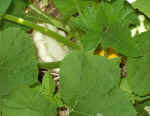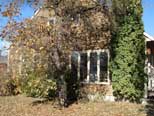Navigation
Resources
Bibliography
Photos
Drawings
Appendix
Journal
Forum
Presentation
Resume
Portfolio
Help
| Implementation I
Results - Garden Extension
One of our main aims with this project is to grow more of our own food. The first goal is to reach a level where we grow 50% of our food needs for a year. We do not know how much growing area is necessary to achieve this. The published numbers in regards to that differ and depends on many factors, including the type of diet and the type of gardening methods used. I came to the conclusion the best thing is to find it out ourselves.
Based on the understanding of what impact gardening can have on the environment and the goal to garden in harmony with nature we use the following guidelines, which are a combination of many influences (among them Manitobu Fukuoka, Ruth Stout, Emilia Hazelip and Toby Hemenway):
- No digging
- Little to no weeding
- Little to no hand watering
- No external fertilizer
- No chemicals
- No pest control
- No power tools
- Using onsite materials as much as possible
To achieve this we are using or developing, among others, the following systems and strategies:
- Hügel-culture
and Hügel-Hoop-Bed
This is an experimental design that combines the design of a Hügel bed or raised bed with features to be able to easily convert them into a bed with a hoop cover over it or into a cold frame.
I have been working with this kind of bed for several years now. The first time a came across "Hügel-Kultur" was in Germany about 20 years ago, when visiting a farmer, who was farming in large greenhouses without heating, using the heat producing Hugel-culture beds even during winter. Another person I visited more recently and is using this concept in combination with animals with great success in large-scale farming is Sepp Holzer.
Once a bed has been build, there is no stepping on it.
- Little to no external input
Well, to set up the beds we brought in soil. One source is not quite clear where it comes from (Idaho stone), the other one is from a pond dug out and based on the owner some university did an analysis and says that the soil is from the Mesozoic time. We are also buying some potting soil.
- Fertility
We keep fertility in different ways - one is using our own compost, and encourage worms. We have been bringing in worm compost and plan to produce this in the future ourselves. As we also plan to keep chickens and rabbits, we should become independent form external fertilizer sources. We rotate the crops each year between the beds and add soil and compost to the top as the HB tend to shrink over the time of a few years.
We are using extensive mulching with straw, which is purchased from a feed store and in fall we are using the leaves from the fruit trees to cover up the beds and perennials, like strawberries.
- Observation and Experimentation = Design
A good example for this is the system of gorinwg strawberries that developed based on expereinces in observations. Usually it is assumed after a few years strawberry plants need to be replaced. My experience is different. And I developed more patience with pests - instead a lot of action to do something about it I obeserved trying to find out how nature deals with it.
- Watering
In order for low maintenance we have set up a simple automatic watering system. A battery powered timer on the outside water faucet with two timers. One goes to the garden area, feeding into a manifold that has 5 separate outlets that can be each individually blocked. From there we have soaker hoses that run into each bed, usually two runs.
- Increasing growing area
- Raised beds
Combination between HB, traditional raised bed with the capability to convert into a cold frame, hoop bed and carrying a future chicken tractor. These beds were designed so only materials from our site are used (old board form the deck and branches to make sticks) without any screws or nails and to accommodate 2 or 3 runs of boards and could be covered with a glass window for cold frames or winter growing/harvesting space.
- Mulching
- Perennials
- Self-seeding
- Polyculture, stacking
- Edible volunteer plants
For example burdock, plantain, dandelion, lambsquart and fairy ring mushroom are all growing without any need to do anything and have all edible parts.
We had to redo about half the beds from the existing garden as they were overgrown with mostly quack grass, as well as the pond and the bed around it, which included moving strawberries, chive and Echinacea.
For the raised beds and hugel-beds we used branches and shrubbery things from the property to build the core and topped it with green stuff (grass clippings, green leaves, plants without seed heads, which we had pulled), grass sods, leaves, a little straw and compost. That gets covered with soil. Underneath all is cardboard. If weeds take over - in spring put cardboard on top, wet it down so it forms to the shape of the bed. Cardboard is for free from local businesses (staples are removed, tape and stickers taken off, some black and white print is ok - other wise no print).
Between the beds we put wood chips from a local site that a friend has organized that landscapers can dump their chipped materials. Made connections to the city for their chips - have to follow up on that.
We have been harvesting so far, rhubarb, strawberries, raspberries, radishes, salads, snow peas, onions, zucchini, cucumber, chive and salads.
We do buy seeds and plants and try to save every year some seeds form our own plants, buidling a small seed stock. When planting or seeding, a marker is written (reusing old flower-pot markers) with the variety name and type of plant, the date planted and the seed or plant vendor.
|


